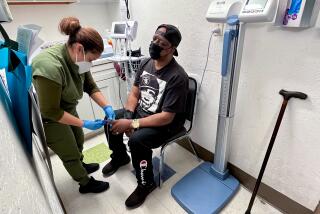Waterproof workout patch studies a surprising source of info: your sweat
Elite athletes must listen carefully to their bodies during workouts and competition. Their muscles. Heart rate. And, sometime soon, maybe even their sweat.
Scientists have created a soft, bandage-like device that collects and analyzes an athlete’s perspiration as they run, bike and even swim underwater.
The sweat sensor, which researchers recently described in the journal Science Advances, could prompt its wearer to replenish fluids and electrolytes lost during a workout.
Our sweat contains a number of chemicals that reflect our overall health, including salts, sugars, hormones, alcohol, drugs and lead. But unlike blood, urine and other bodily fluids, relatively little research has gone into using sweat to gauge conditions inside our bodies.
“A lot of the chemistry that’s happening in the body shows up in the sweat,” said materials scientist John Rogers, whose research group at Northwestern University developed the device.
The circular plastic patch measures 1.5 inches across and sticks to the skin like a bandage. Embedded within are a few electronic gizmos that transmit information on the amount of sweat and temperature of the skin to a smartphone and allow the device to charge wirelessly.
A hair-sized opening at the center collects a small volume of sweat, which fills a “microchannel” that snakes around the face of the device in a serpentine pattern similar to a flower. It’s like a bendy straw, only a thousand times smaller.
“Sweat glands can push sweat through these really tiny channels,” Rogers said.
Over time, the excretions mix and react with chemicals in the device’s microchannels that cause the fluid to change colors. As the channels fill up, the sweat mixes with food dye in the serpentine channel and turns blue. This indicates the amount of sweat the wearer has lost. Another chamber changes color as electrolytes are lost, going from light pink to dark red.
“It’s almost like a time-dynamic skin tattoo,” he said. “It becomes pretty engaging for the individual because you can watch what’s going on with your body chemistry on the device.”
The wearer would take a picture of the patch with the camera on his or her smartphone, and an app would tell him or her how much water to drink. Tick marks on the patch that correspond to sweat loss could indicate how much hydration the user needs.
Previously, athletes would have to guess how much they needed to replenish, and guessing wrong is common.
A study of more than 2,000 athletes in eight endurance events found that as many as 1% of them drank so much water they developed hyponatremia, a swelling of cells caused by low or diluted sodium levels in the blood. Other studies have reported that up to a quarter of ultra-marathoners and Ironman triathletes and 17% of endurance swimmers have shown asymptomatic signs of the condition.
On the other hand, in hot environments, dehydration can lead to heatstroke and exhaustion. Heatstroke is among the leading causes of death in athletes in July and August, according to the American Orthopaedic Society for Sports Medicine.
Smart skin sensors are an invention whose time has come, analysts say.
A report last year by research firm IDTechEx estimated the market for such devices at around $4.8 billion, based on an analysis of more than 80 companies and 95 existing products. The report predicts revenues will increase to $10 billion in five years and approach $15 billion by 2028.
In the last decade, sweat-sensing technology has become an area of increasing interest to scientists and engineers. That certainly includes Rogers, who has put “sweat analytics” front and center within his research group.
This month, Rogers and colleagues introduced a similar skin patch that monitors the temperature and acidity of sweat, along with levels of glucose, lactate and salts. Although more sophisticated from a clinical standpoint, that device didn’t work underwater.
Aside from their appeal to athletes, the devices have the potential to replace invasive clinical tests, such as blood draws.
“Sweat is relatively underexplored as a biofluid,” Rogers said.
Eventually, such devices could be used to assess body asymmetry in stroke patients, screen for diabetes, or detect kidney dysfunction by measuring creatinine and urea levels in the sweat.
Rogers’ wearable sweat sensors are already in clinical use at Lurie Children’s Hospital of Chicago. Doctors and nurses count on the skin patches to screen newborns for cystic fibrosis by measuring the amount of chloride in their sweat.
In July, researchers at Stanford described a similar device to measure levels of the stress hormone cortisol in their test subjects’ sweat.
Although the clinical applications are promising, Rogers says the more immediate use for sweat-sensing devices is in the realm of sports and fitness.
To put the devices through “a great extreme-test case,” a member of Rogers’ research group brought some samples to Kona, Hawaii, for the Ironman World Championship in October 2017.
There, 12 triathletes stuck the sweat sensors to their forearms as they swam in the ocean for an average of 45 minutes. The devices stayed in place for the duration of their two-hour workouts. The tests were sponsored and coordinated by the Gatorade Sports Science Institute.
Rogers said he had worn the devices many times while using various exercise machines or during pick-up basketball games and tennis matches.
By his assessment, the experience is similar to wearing a bandage — though more comfortable — and they don’t hurt to remove.
“You’re on the treadmill, you’re checking your heart rate and your calories burned, and now you’re checking your sweat loss,” Rogers said. “It’s kind of an additional way to think about your workout.”







